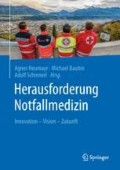Zusammenfassung
In Baden-Württemberg wurde eine zentrale Stelle zur landesweiten externen Qualitätssicherung für den Rettungsdienst implementiert, die auf Grundlage eines integrativen Datenmodells Qualitätsindikatoren berechnet. Besonders wesentliche Aspekte des organisatorischen Einsatzablaufs und der rettungsdienstlichen Versorgungsqualität sollen mithilfe der Qualitätsindikatoren herausgestellt und eine objektive Vergleichbarkeit ermöglicht werden. Grundlegende Voraussetzung für die einrichtungs-/ organisationsübergreifende Anwendung von Qualitätsindikatoren ist die Vergleichbarkeit der Daten unterschiedlicher Herkunft hinsichtlich ihres Formats und ihres Inhalts. Einheitliche Datensatzdefinitionen und abgestimmte Vorgehensweisen für die Datenerhebung sind daher empfehlenswert. Auch wenn Qualitätsindikatoren gut messbar und leicht zu handhaben sind, müssen die Ergebnisse individuell und kritisch betrachtet werden, um Fehlinterpretationen zu vermeiden. Schlechte Werte sind nicht per se mit schlechter Qualität gleichzusetzen. Diese sind lediglich ein Hinweis, dass möglicherweise ein Qualitätsproblem in dem beobachteten Bereich vorliegt und aus diesem Grund eine weitere Prüfung, beispielsweise im Rahmen des internen Qualitätsmanagements, erfolgen sollte. Nicht zuletzt hängt die Belastbarkeit der Ergebnisse von der Güte der zugrunde liegenden Daten ab, die wiederum maßgeblich durch die Qualität der Dokumentation gesteuert wird. Eine umfangreiche Datenvalidierung ist zwingend notwendig.
Access this chapter
Tax calculation will be finalised at checkout
Purchases are for personal use only
Literatur
Celso B, Tepas J, Langland-Orban B et al (2006) A systematic review and meta-analysis comparing outcome of severely injured patients treated in trauma centers following the establishment of trauma systems. J Trauma Acute Care Surg 60:371–378
Clancy CM (1997) Ensuring health care quality: an AHCPR perspective. Agency for Health Care Policy and Research. Clin Ther 19:1564–1571
Deutsche Gesellschaft für Unfallchirurgie (2012) Weißbuch Schwerverletztenversorgung. Empfehlungen zu Struktur, Organisation, Ausstattung sowie Förderung von Qualität und Sicherheit in der Schwerverletzten-Versorgung in der Bundesrepublik Deutschland. Thieme, Stuttgart
Deutsche Gesellschaft für Unfallchirurgie (2016) S3-Leitlinie Polytrauma /Schwerverletzten-Behandlung. http://www.awmf.org/uploads/tx_szleitlinien/012-019l_S3_Polytrauma_Schwerverletzten-Behandlung_2017-08.pdf. Zugegriffen: 15. Febr. 2018
Eddy DM (1998) Performance measurement: problems and solutions. Health Aff 17:7–25
ESC Committee for Practice Guidelines (CPG) (2012) ESC Guidelines for the management of acute myocardial infarction in patients presenting with ST-segment elevation. The Task Force on the management of ST-segment elevation acute myocardial infarction of the European Society of Cardiology (ESC). Europ Heart J 33:2569–2619
Fischer M et al (2016) Eckpunktepapier 2016 zur notfallmedizinischen Versorgung der Bevölkerung in der Prähospitalphase und in der Klinik. Notfall Rettungsmed 19:1–9
Keeley EC, Boura JA, Grines CL (2003) Primary angioplasty vs. intravenous thrombolytic therapy for acute myocardial infarction: a quantitative review of 23 randomised trials. Lancet 361:13–20
Liberman M, Mulder DS, Jurkovich GJ, Sampalis JS (2005) The association between trauma system and trauma center components and outcome in a mature regionalized trauma system. Surgery 137:647–658
Mainz J (2003) Defining and classifying clinical indicators for quality improvement. Int J Qual Health Care 15:523–530
McGlynn EA (1998) Choosing and evaluating clinical performance measures. Jt Comm J Qual Improv 24:470–479
Messelken M, Kehrberger E, Dirks B, Fischer M (2010) The quality of emergency medical care in Baden-Württemberg (Germany): four years in focus. Dtsch Arztebl Int 107:523–530
Nirula R, Brasel K (2006) Do trauma centers improve functional outcomes: a national trauma databank analysis? J Trauma Acute Care Surg 61:268–271
Reiter A, Fischer B, Kötting J et al (2007) QUALIFY: Ein Instrument zur Bewertung von Qualitätsindikatoren. Z Arztl Fortbild Qualitatssicherung 101:683–688
Schober A, Holzer M, Hochrieser H et al (2014) Effect of intensive care after cardiac arrest on patient outcome: a database analysis. Crit Care 18:R84
Sens B, Fischer B, Bastek A et al (2007) Begriffe und Konzepte des Qualitätsmanagements. 3. Aufl. GMS Med Inform Biom Epidemiol 3:Doc05
Tinkoff GH, O’Connor RE, Alexander EL III, Jones MS (2007) The Delaware trauma system: impact of level III trauma centers. J Trauma Acute Care Surg 63:121–126
Utter GH, Maier RV, Rivara FP et al (2006) Inclusive trauma systems: do they improve triage or outcomes of the severely injured? J Trauma Acute Care Surg 60:529–535
Widimsky P, Budesinsky T, Vorac D et al (2003) Long distance transport for primary angioplasty vs. immediate thrombolysis in acute myocardial infarction. Final results of the randomized national multicentre trial – PRAGUE-2. Europ Heart J 24:94–104
Zeymer U, Zahn R (2013) Aktuelle Leitlinienempfehlungen zur Logistik der Versorgung von Patienten mit akutem ST-Streckenhebungsmyokardinfarkt. Hinweise zur Organisation von Herzinfarktnetzwerken. Notfall Rettungsmed 16:16–21
Author information
Authors and Affiliations
Corresponding author
Editor information
Editors and Affiliations
Rights and permissions
Copyright information
© 2018 Springer-Verlag GmbH Deutschland, ein Teil von Springer Nature
About this chapter
Cite this chapter
Lohs, T. (2018). Qualitätssicherung im Rettungsdienst Baden-Württemberg. In: Neumayr, A., Baubin, M., Schinnerl, A. (eds) Herausforderung Notfallmedizin. Springer, Berlin, Heidelberg. https://doi.org/10.1007/978-3-662-56627-5_21
Download citation
DOI: https://doi.org/10.1007/978-3-662-56627-5_21
Published:
Publisher Name: Springer, Berlin, Heidelberg
Print ISBN: 978-3-662-56626-8
Online ISBN: 978-3-662-56627-5
eBook Packages: Medicine (German Language)

